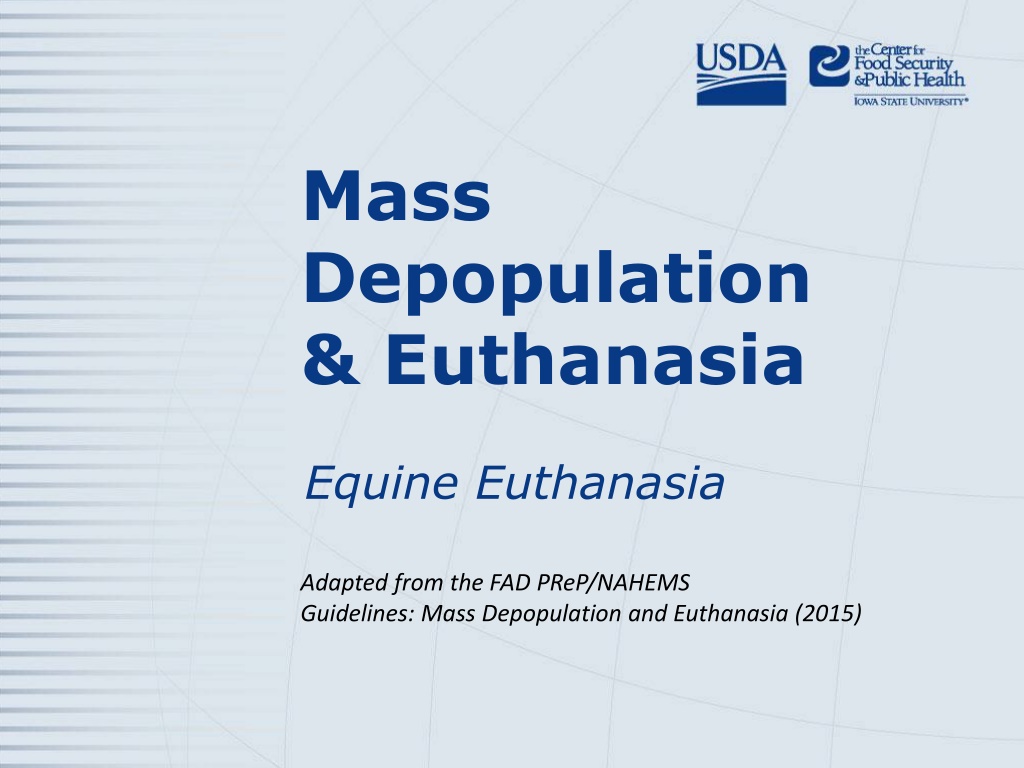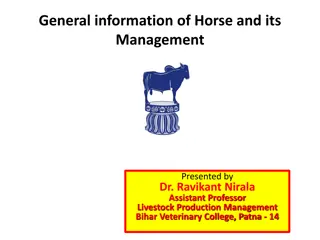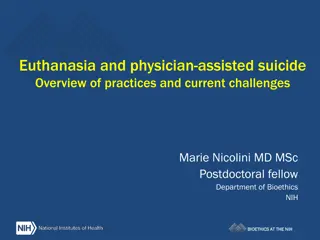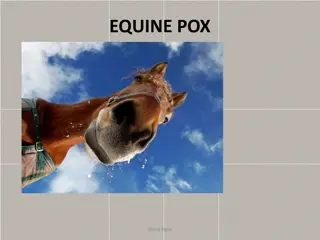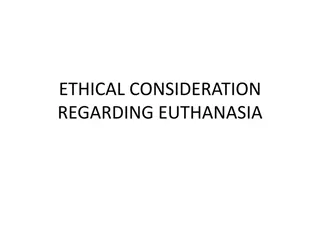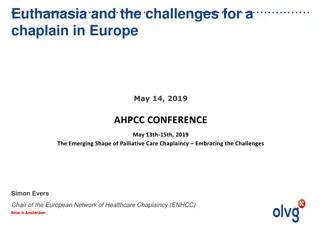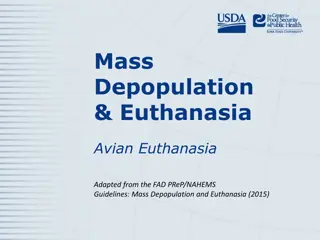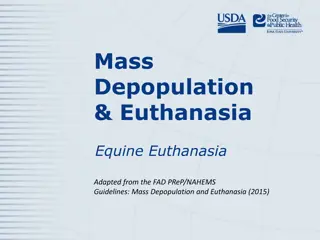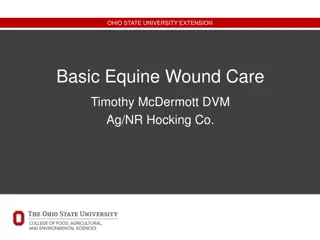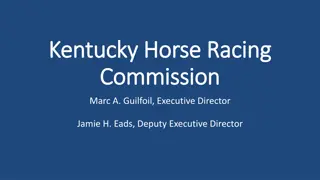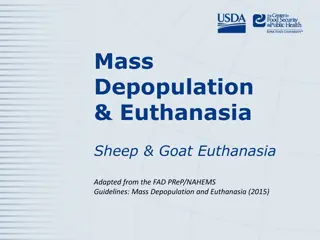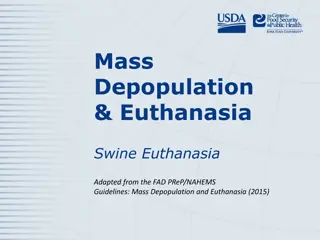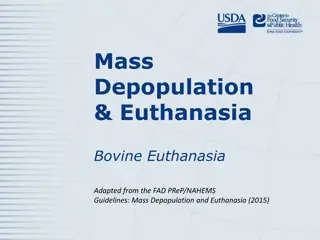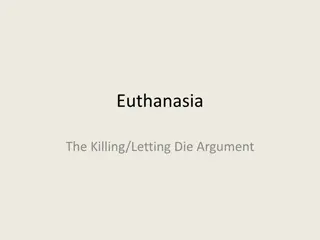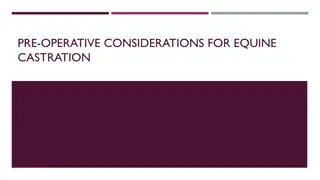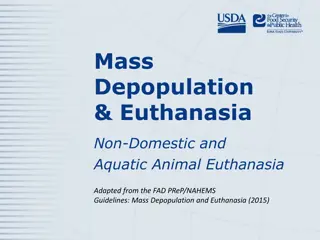Equine Euthanasia Guidelines: Best Practices and Considerations
Equine euthanasia and mass depopulation guidelines emphasize humane treatment, efficient methods, and minimizing emotional impact during animal health emergencies. Techniques such as sedation, acceptable injection methods, and handling protocols are outlined to ensure a stress-free transition for equines. Consideration to animal welfare, prevention of disease spread, and safeguarding the food chain are key goals addressed in the guidelines.
Download Presentation

Please find below an Image/Link to download the presentation.
The content on the website is provided AS IS for your information and personal use only. It may not be sold, licensed, or shared on other websites without obtaining consent from the author. Download presentation by click this link. If you encounter any issues during the download, it is possible that the publisher has removed the file from their server.
E N D
Presentation Transcript
Mass Depopulation & Euthanasia Equine Euthanasia Adapted from the FAD PReP/NAHEMS Guidelines: Mass Depopulation and Euthanasia (2015)
Euthanasia and Depopulation Euthanasia Transitioning painlessly and stress-free as possible Mass Depopulation Large numbers, quickly and efficiently Consideration to welfare as practicable Terms used interchangeably here FAD PReP/NAHEMS Guidelines: MDE-Equine USDA APHIS and CFSPH
Euthanasia and Depopulation May be practiced during an animal health emergency Goals of Euthanasia Provide humane treatment Select acceptable method Minimize negative emotional impact Safeguard food chain Prevent or mitigate disease spread FAD PReP/NAHEMS Guidelines: MDE-Equine USDA APHIS and CFSPH
Handling Goal: Humane Treatment Decrease animal stress, excitement Do not force animals to travel quickly Avoid electric prods, whips Human body position Flight zones Flags Plastic paddles Handle animals quietly FAD PReP/NAHEMS Guidelines: MDE-Equine USDA APHIS and CFSPH USDA APHIS and CFSPH
Sedation May not be practical in emergency response May complicate disposal Methods of sedation Intravenous Intramuscular via pole syringe FAD PReP/NAHEMS Guidelines: MDE-Equine USDA APHIS and CFSPH
Euthanasia Methods Acceptable (noninhalant injectable) Barbiturates Barbiturate derivatives Conditionally Acceptable (physical) Penetrating captive bolt Gunshot Adjunct methods KCL FAD PReP/NAHEMS Guidelines: MDE-Equine USDA APHIS and CFSPH
Noninhalant Injectables Used if animal considered companion Practical for tractable equines, but slow process Barbiturates most common Sedation prior to euthanasia highly recommended Chemical residue concerns FAD PReP/NAHEMS Guidelines: MDE-Equine USDA APHIS and CFSPH
Physical- Captive Bolt Appropriate restraint Sedate animals as needed Ensure proper bolt position Bolt Position Place flat against forehead 45 angle from horizontal Have adjunct measure available FAD PReP/NAHEMS Guidelines: MDE-Equine USDA APHIS and CFSPH
Physical- Gunshot Conditionally acceptable Species-appropriate ammunition, appropriate caliber weapon Proper training, skills, experience At close range, same point of entry as captive bolt Muzzle should not contact head FAD PReP/NAHEMS Guidelines: MDE-Equine USDA APHIS and CFSPH
Adjunct Methods If primary euthanasia measure fails to cause rapid death, adjunct measure must be applied Examples for equids include: IV KCl solution IV narcotics Pithing FAD PReP/NAHEMS Guidelines: MDE-Equine USDA APHIS and CFSPH
Confirmation of Death Confirmation of death can be difficult Sustained lack of heartbeat and respiration Rigor mortis Evaluate by competent, experienced personnel USDA APHIS and CFSPH FAD PReP/NAHEMS Guidelines: MDE-Equine
For More Information FAD PReP/NAHEMS Guidelines: Mass Depopulation and Euthanasia (MDE) (2015) http://www.aphis.usda.gov/fadprep MDE web-based training module http://naherc.sws.iastate.edu/ FAD PReP/NAHEMS Guidelines: MDE-Equine USDA APHIS and CFSPH
Guidelines Content Authors (CFSPH): Rene Dewell DVM,MS Nichollette Rider, Veterinary Student Significant contributions to the content were provided by USDA APHIS VS: Lori P. Miller, PE Darrel K. Styles, DVM, PhD FAD PReP/NAHEMS Guidelines: MDE-Equine USDA APHIS and CFSPH
Acknowledgments Development of this presentation was by the Center for Food Security and Public Health at Iowa State University through funding from the USDA APHIS Veterinary Services PPT Authors: Dawn Bailey, BS; Kerry Leedom Larson, DVM, MPH, PhD, DACVPM Reviewers: Glenda Dvorak, DVM, MPH, DACVPM: Cheryl L. Eia, JD, DVM, MPH, Patricia Futoma, BS, Veterinary Student, Rene Dewell DVM,MS
